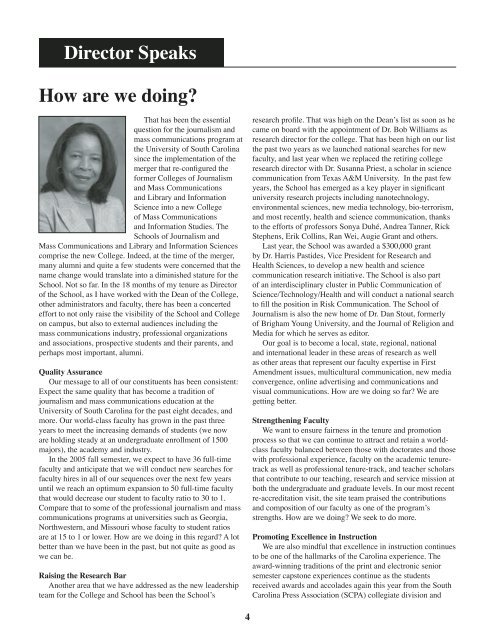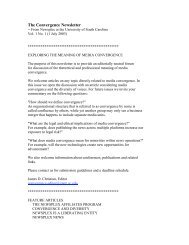Summer 2005 - School of Journalism and Mass Communications
Summer 2005 - School of Journalism and Mass Communications
Summer 2005 - School of Journalism and Mass Communications
You also want an ePaper? Increase the reach of your titles
YUMPU automatically turns print PDFs into web optimized ePapers that Google loves.
Director Speaks<br />
How are we doing?<br />
That has been the essential<br />
question for the journalism <strong>and</strong><br />
mass communications program at<br />
the University <strong>of</strong> South Carolina<br />
since the implementation <strong>of</strong> the<br />
merger that re-configured the<br />
former Colleges <strong>of</strong> <strong>Journalism</strong><br />
<strong>and</strong> <strong>Mass</strong> <strong>Communications</strong><br />
<strong>and</strong> Library <strong>and</strong> Information<br />
Science into a new College<br />
<strong>of</strong> <strong>Mass</strong> <strong>Communications</strong><br />
<strong>and</strong> Information Studies. The<br />
<strong>School</strong>s <strong>of</strong> <strong>Journalism</strong> <strong>and</strong><br />
<strong>Mass</strong> <strong>Communications</strong> <strong>and</strong> Library <strong>and</strong> Information Sciences<br />
comprise the new College. Indeed, at the time <strong>of</strong> the merger,<br />
many alumni <strong>and</strong> quite a few students were concerned that the<br />
name change would translate into a diminished stature for the<br />
<strong>School</strong>. Not so far. In the 18 months <strong>of</strong> my tenure as Director<br />
<strong>of</strong> the <strong>School</strong>, as I have worked with the Dean <strong>of</strong> the College,<br />
other administrators <strong>and</strong> faculty, there has been a concerted<br />
effort to not only raise the visibility <strong>of</strong> the <strong>School</strong> <strong>and</strong> College<br />
on campus, but also to external audiences including the<br />
mass communications industry, pr<strong>of</strong>essional organizations<br />
<strong>and</strong> associations, prospective students <strong>and</strong> their parents, <strong>and</strong><br />
perhaps most important, alumni.<br />
Quality Assurance<br />
Our message to all <strong>of</strong> our constituents has been consistent:<br />
Expect the same quality that has become a tradition <strong>of</strong><br />
journalism <strong>and</strong> mass communications education at the<br />
University <strong>of</strong> South Carolina for the past eight decades, <strong>and</strong><br />
more. Our world-class faculty has grown in the past three<br />
years to meet the increasing dem<strong>and</strong>s <strong>of</strong> students (we now<br />
are holding steady at an undergraduate enrollment <strong>of</strong> 1500<br />
majors), the academy <strong>and</strong> industry.<br />
In the <strong>2005</strong> fall semester, we expect to have 36 full-time<br />
faculty <strong>and</strong> anticipate that we will conduct new searches for<br />
faculty hires in all <strong>of</strong> our sequences over the next few years<br />
until we reach an optimum expansion to 50 full-time faculty<br />
that would decrease our student to faculty ratio to 30 to 1.<br />
Compare that to some <strong>of</strong> the pr<strong>of</strong>essional journalism <strong>and</strong> mass<br />
communications programs at universities such as Georgia,<br />
Northwestern, <strong>and</strong> Missouri whose faculty to student ratios<br />
are at 15 to 1 or lower. How are we doing in this regard? A lot<br />
better than we have been in the past, but not quite as good as<br />
we can be.<br />
Raising the Research Bar<br />
Another area that we have addressed as the new leadership<br />
team for the College <strong>and</strong> <strong>School</strong> has been the <strong>School</strong>’s<br />
research pr<strong>of</strong>ile. That was high on the Dean’s list as soon as he<br />
came on board with the appointment <strong>of</strong> Dr. Bob Williams as<br />
research director for the college. That has been high on our list<br />
the past two years as we launched national searches for new<br />
faculty, <strong>and</strong> last year when we replaced the retiring college<br />
research director with Dr. Susanna Priest, a scholar in science<br />
communication from Texas A&M University. In the past few<br />
years, the <strong>School</strong> has emerged as a key player in significant<br />
university research projects including nanotechnology,<br />
environmental sciences, new media technology, bio-terrorism,<br />
<strong>and</strong> most recently, health <strong>and</strong> science communication, thanks<br />
to the efforts <strong>of</strong> pr<strong>of</strong>essors Sonya Duhé, Andrea Tanner, Rick<br />
Stephens, Erik Collins, Ran Wei, Augie Grant <strong>and</strong> others.<br />
Last year, the <strong>School</strong> was awarded a $300,000 grant<br />
by Dr. Harris Pastides, Vice President for Research <strong>and</strong><br />
Health Sciences, to develop a new health <strong>and</strong> science<br />
communication research initiative. The <strong>School</strong> is also part<br />
<strong>of</strong> an interdisciplinary cluster in Public Communication <strong>of</strong><br />
Science/Technology/Health <strong>and</strong> will conduct a national search<br />
to fill the position in Risk Communication. The <strong>School</strong> <strong>of</strong><br />
<strong>Journalism</strong> is also the new home <strong>of</strong> Dr. Dan Stout, formerly<br />
<strong>of</strong> Brigham Young University, <strong>and</strong> the Journal <strong>of</strong> Religion <strong>and</strong><br />
Media for which he serves as editor.<br />
Our goal is to become a local, state, regional, national<br />
<strong>and</strong> international leader in these areas <strong>of</strong> research as well<br />
as other areas that represent our faculty expertise in First<br />
Amendment issues, multicultural communication, new media<br />
convergence, online advertising <strong>and</strong> communications <strong>and</strong><br />
visual communications. How are we doing so far? We are<br />
getting better.<br />
Strengthening Faculty<br />
We want to ensure fairness in the tenure <strong>and</strong> promotion<br />
process so that we can continue to attract <strong>and</strong> retain a worldclass<br />
faculty balanced between those with doctorates <strong>and</strong> those<br />
with pr<strong>of</strong>essional experience, faculty on the academic tenuretrack<br />
as well as pr<strong>of</strong>essional tenure-track, <strong>and</strong> teacher scholars<br />
that contribute to our teaching, research <strong>and</strong> service mission at<br />
both the undergraduate <strong>and</strong> graduate levels. In our most recent<br />
re-accreditation visit, the site team praised the contributions<br />
<strong>and</strong> composition <strong>of</strong> our faculty as one <strong>of</strong> the program’s<br />
strengths. How are we doing? We seek to do more.<br />
Promoting Excellence in Instruction<br />
We are also mindful that excellence in instruction continues<br />
to be one <strong>of</strong> the hallmarks <strong>of</strong> the Carolina experience. The<br />
award-winning traditions <strong>of</strong> the print <strong>and</strong> electronic senior<br />
semester capstone experiences continue as the students<br />
received awards <strong>and</strong> accolades again this year from the South<br />
Carolina Press Association (SCPA) collegiate division <strong>and</strong><br />
4







